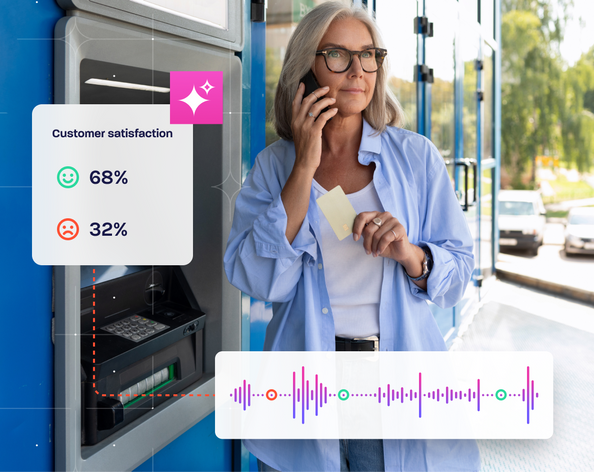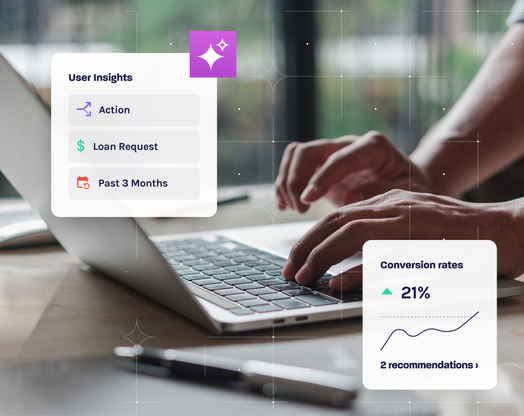
Enhancing Customer Experience in Financial Services
Customer experience in financial services now plays a defining role in customer loyalty, satisfaction and growth. As expectations shift, routine transactions are no longer enough—customers want seamless, responsive service across every digital and in-person interaction. Whether opening an account, applying for a loan or managing insurance claims, the overall customer experience directly impacts retention and brand trust.
To keep pace, financial institutions are rethinking how they design and deliver customer journeys. Tools like AI-powered analytics, customer journey mapping and real-time digital performance monitoring are giving banks, credit unions, insurers and fintech firms a clearer view of where friction occurs—and how to fix it.
In this article, we’ll explore strategies to improve customer experience at scale, from optimizing key digital touchpoints to using personalization and real-time data to anticipate customer needs. For financial organizations navigating rising expectations and regulatory demands, these steps can help create more consistent, compliant and engaging customer experiences.
What Is Customer Experience in Financial Services?
Customer experience in financial services is shaped by every interaction a person has with a financial institution—whether that’s using a mobile banking app, connecting with a loan advisor or filing an insurance claim. These experiences influence how customers perceive trust, value and reliability, and ultimately whether they stay loyal or look elsewhere.
As customer expectations continue to rise, so does the pressure to deliver frictionless service across every channel. Most customers now prefer to manage their accounts digitally, but many still rely on personalized service for more complex needs. Institutions that blend digital convenience with human support are best positioned to build long-term trust and loyalty.
Let’s take a closer look at how different financial sectors approach customer experience and where the biggest opportunities lie.
CX for Banks
Banks that deliver a great customer experience are the ones that make digital tools easy to use without losing the human connection. From mobile check deposits to bill payments, customers expect fast and seamless digital banking. But when it comes to higher-stakes decisions, like mortgage applications or financial planning, human support still plays an essential role. The most effective CX strategies bridge these experiences into a unified, personalized journey.
CX for Credit Unions
Credit unions are known for their personal touch, and digital transformation doesn’t have to come at the cost of that closeness. By adopting scalable, member-centric technology, credit unions can preserve their relationship-driven model while expanding access to digital services. Whether it’s an online loan application or a virtual financial consultation, thoughtful digital tools help maintain high customer satisfaction and deepen member loyalty.
CX for Insurance
When policyholders file a claim, speed and empathy matter most. Insurance companies that pair fast claims processing with clear, compassionate communication can turn stressful moments into opportunities to build trust. Tools that monitor digital journeys in real time help teams identify where delays or confusion occur, so they can proactively improve the experience and reduce frustration.
CX for Fintech
Fintech companies are built around intuitive, self-service tools and their customer base expects instant, personalized insights. From real-time account updates to tailored investment suggestions, every interaction must feel effortless. Many fintechs use AI and behavioral data to predict what customers need and respond in the moment. Getting that balance right is key to delivering a truly modern, personalized experience.
Keeping these models in mind, the next section explores why delivering great customer experience has gone from optional to essential for every financial institution.
Why Customer Experience Matters for Financial Institutions
Customer experience in financial services has evolved from a supporting function into a strategic imperative. Today, customer retention, trust and even regulatory compliance often hinge on whether an institution can deliver a seamless, responsive experience.
With more consumers expecting instant, personalized service across every touchpoint, institutions that fail to meet these expectations risk losing customers to more agile competitors. Even in traditional sectors like banking and insurance, customer loyalty increasingly depends on the quality of the digital experience—not just the product or rate being offered.
A strong customer experience builds long-term trust by making every interaction easy and transparent, from mobile banking to policy renewals. It also supports compliance by helping institutions respond proactively to customer needs—an approach that aligns with regulations like GDPR and Consumer Duty. And when executed well, customer experience strategies directly reduce churn and improve satisfaction across the entire customer lifecycle.
For financial institutions, CX is no longer optional; it’s a defining factor in whether customers stay, leave or recommend your brand to others.
Top Challenges in Financial Services CX
While the benefits of strong CX are clear, reaching that level of consistency across digital and in-person channels can be difficult, especially for complex financial organizations. Siloed systems, aging infrastructure and data blind spots often stand in the way of a truly seamless experience.
Siloed Systems and Disjointed Journeys
Disconnected platforms are a major challenge. Customers are often forced to re-enter information, switch between channels or verify their identity multiple times. These friction points not only create frustration—they also make it harder for teams to understand and improve the customer journey. Without unified data, delivering personalized service or resolving issues quickly becomes nearly impossible.
Centralizing data and aligning cross-functional teams around a single view of the customer journey is a key first step toward reducing drop-off and improving overall customer satisfaction.
Technical Friction and Lagging Issue Resolution
Performance issues, such as slow load times, stalled applications or broken payment flows, can derail even the most promising digital experiences. And when troubleshooting is handled manually or reactively, it only adds to customer frustration. A user who encounters repeated errors may abandon their transaction—or worse, their relationship with your institution.
Real-time monitoring tools help identify issues as they happen, allowing teams to intervene before customers encounter a dead end. Reducing technical friction strengthens digital experience and reinforces trust in your brand.
Underutilized Data and Legacy Limitations
Many financial services organizations collect extensive customer data but lack the modern tools to act on it. Legacy systems often can’t support the level of real-time insight needed to deliver a personalized experience or anticipate customer needs.
Without access to behavioral analytics, financial institutions risk missing key moments, like when to surface a relevant product, resolve a recurring service issue or retain a high-value customer. Investing in scalable, AI-powered solutions can help bridge this gap, making data not only usable, but actionable.
With these challenges in mind, let’s explore the best practices that can help you overcome them and deliver the kind of experience customers expect.
Best Practices to Elevate Customer Experience
To overcome common barriers like siloed systems, technical friction and untapped data, financial institutions need more than quick fixes—they need a strategic approach. Proven methods like customer journey mapping and AI-powered analytics don’t just improve digital banking performance; they help drive measurable gains in customer satisfaction, loyalty and cost efficiency.
Here’s how leading financial organizations are elevating customer experience across every touchpoint:
Unify Customer Journeys Across Web, Mobile and In-Person Channels
The most effective customer experience strategies start with a complete view of each interaction. When institutions map journeys across digital and in-branch channels, they can quickly identify gaps (like when a customer starts a loan application on mobile but is forced to repeat steps on desktop).
Tools like Glassbox’s customer journey analytics provide real-time visibility into where users encounter friction. If a particular form sees frequent drop-offs, teams can make targeted improvements that reduce frustration and drive conversion. Unifying these insights helps eliminate redundancies, align teams and deliver more consistent customer experiences across the board.
Optimize Digital Performance With Real-Time Monitoring
Even the best-designed journeys can be derailed by technical issues. From lagging page loads to broken payment flows, digital friction costs more than conversions—it impacts trust.
Real-time monitoring helps teams catch these issues the moment they occur. Performance thresholds can be set to automatically flag slow pages or rising error rates, enabling faster resolutions and fewer disruptions. When customers can move through key tasks, like applications or claims, without delay, satisfaction naturally rises.
This continuous optimization lays the foundation for more personalized digital experiences.
Leverage Ethical AI for Hyper-Relevant Personalization
AI has become essential in delivering the personalized financial experiences today’s customers expect. By analyzing session behavior and digital patterns, AI tools help tailor offers, content and workflows based on actual customer intent, not assumptions.
For example, if a user frequently visits mortgage calculators but abandons the process mid-way, AI can surface personalized assistance or alternative pathways. This level of relevance boosts engagement, improves outcomes and demonstrates responsiveness.
But personalization must be handled with care. Ethical AI ensures that customer data is used responsibly and in compliance with regulations like GDPR, protecting both the individual and the institution. When done right, it builds trust while improving conversion rates.
Adopt Proactive Issue Resolution Workflows
Friction happens, but how you respond matters. Automated alerts and session-level monitoring allow teams to detect recurring pain points, such as repeated password resets or stalled transfers. Instead of waiting for customers to report problems, institutions can resolve them behind the scenes, preventing churn and reducing strain on support teams.
This proactive approach fosters a more seamless experience and reassures customers that their financial institution is always one step ahead.
Modernize Legacy Infrastructure With Agile Integrations
Modernizing CX doesn’t always mean replacing your systems. In fact, many financial services organizations extend the value of their legacy infrastructure by layering in flexible, AI-powered analytics.
These integrations help unlock real-time insights from existing systems, bridging the gap between siloed data and a complete customer view. With a more agile foundation, teams can make faster, smarter decisions and adapt experiences at scale.
This sets the stage for the final piece of a connected strategy: using the right tools to bring everything together in one platform.
Build a Better CX Strategy With Glassbox
Delivering a standout customer experience in financial services starts with visibility. When you can see every interaction, eliminate data silos and act on real-time insights, you’re equipped to resolve issues before they impact satisfaction or compliance.
Glassbox helps institutions achieve just that. Our AI-powered platform translates digital behavior into actionable intelligence, enabling teams to optimize journeys, reduce operational costs and meet regulatory standards like Consumer Duty and GDPR.
What sets our platform apart?
Seamless Data Integration connects with legacy systems and modern environments—no overhauls required
Real-Time Analytics track every click, tap and swipe so you can respond as friction happens
Scalable Architecture supports banks, credit unions, insurers and fintech firms at every stage of growth
Whether you’re refining application flows or surfacing hidden drop-off points, Glassbox gives you the tools to move from reactive service to proactive experience management.
Ready to unlock a more seamless, personalized and compliant CX? Take our maturity assessment to see where you stand, or explore the platform tour to see what’s possible.







